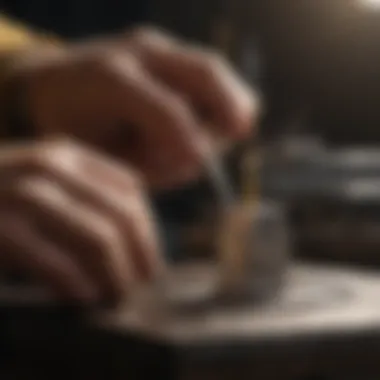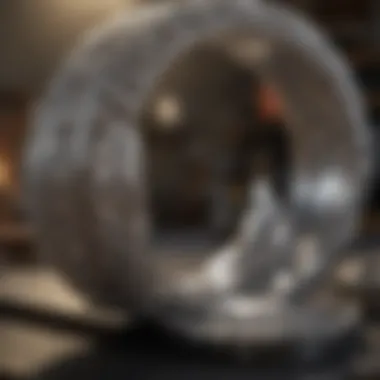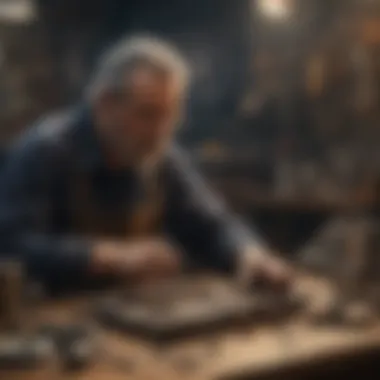Mastering the Art of Silversmithing: A Comprehensive Guide to Soldering Kits


Rock and Fossil Identification
Silversmithing, with its intricate nature, shares similarities with the careful examination required in identifying rocks and fossils. Just as a silversmith looks for specific characteristics in silver to create masterpieces, a rock and fossil collector must understand the types of rocks and fossils, taking note of unique characteristics that set them apart.
For rocks, one may encounter igneous, sedimentary, and metamorphic rock types, each with distinct features. Similarly, fossils can range from petrified wood to ammonites, each displaying unique patterns that aid in identification. Utilizing tools such as magnifying glasses and hardness testing kits can be invaluable in the identification process, offering a closer look at texture, color variations, and hardness.
Collecting Tips and Techniques
In the realm of silversmithing, precision and careful handling of materials are imperative for creating impeccable pieces. Likewise, in rock and fossil collecting, adhering to best practices is essential to procure specimens effectively. Embracing techniques such as stratigraphy analysis can help collectors locate prime sites rich in fossils or unique geological formations.
When it comes to extracting specimens, delicacy is key to preserving the integrity of the find. Properly documenting the location and context of the discovery, using tools like brushes and chisels, ensures the safe extraction of specimens without damaging them. By following these meticulous techniques, collectors can amass a valuable and well-preserved collection.
Preservation and Display
The art of silversmithing extends beyond crafting to the preservation and display of completed works, emphasizing the importance of maintaining quality over time. Similarly, in the world of rock and fossil collecting, preserving specimens ensures their longevity and scientific value. Employing techniques like stabilization and protective coatings can help prevent deterioration of fossils or rocks.
Furthermore, selecting suitable storage methods such as acid-free containers and climate-controlled environments safeguards specimens from decay. Creative display ideas, akin to showcasing silver jewelry in elegant settings, allow collectors to exhibit their treasures aesthetically, enhancing their visual appeal and informational value.
Geological Insights
Delving into the depths of silversmithing involves understanding the geological processes that form precious metals and gemstones. Likewise, rock and fossil collectors delve into the geological insights offered by various formations. Studying the historical significance of specific rocks or fossils provides insight into past environments and evolutionary patterns.
By exploring notable discoveries in the field, collectors gain a deeper appreciation for the scientific contributions made by previous findings. Understanding geological formations and the processes that shape them offers a profound insight into the Earth's history, enriching the collector's knowledge and appreciation for the natural world.
Introduction
In the vast realm of silversmithing, mastery of the craft hinges greatly on the adept utilization of soldering kits. These fundamental tools serve as the backbone of intricate silverwork, enabling artisans to merge and shape precious metals with unparalleled precision. Throughout this exhaustive guide, we will delve deep into the art and science of soldering, unraveling the nuances that elevate amateur creations into masterpieces of silver. The convergence of creativity and technical skill within the domain of silversmithing finds its zenith in the judicious application of soldering kits.
Understanding Silversmithing
History of Silversmithing
A pivotal element in the evolution of metallurgy, the history of silversmithing unfolds as a narrative rich with cultural significance and technical innovation. From ancient civilizations to modern ateliers, the art of silver manipulation has been revered for its enduring elegance and intrinsic value. Within this context, the historical trajectory of silversmithing not only chronicles the development of artisanal techniques but also mirrors the societal shifts that shape our artistic sensibilities. The legacy of silversmithing stands as a testament to human ingenuity, intertwining beauty and utility in a harmonious blend that transcends temporal boundaries.
Significance of Silversmithing in Artisanal Crafts
The allure of silversmithing in artisanal crafts lies in its capacity to transform ordinary materials into extraordinary works of art. Amidst a landscape dominated by mass production and fleeting trends, the enduring appeal of handcrafted silver pieces serves as a reminder of the timeless union between skill and creativity. By harnessing the traditions of silversmithing, artisans infuse a sense of heritage and authenticity into their creations, resonating with collectors who seek connection beyond mere aesthetics. The significance of silversmithing in artisanal crafts thus extends far beyond the tangible, embodying a narrative of craftsmanship that spans generations.
Essential Tools and Equipment


Overview of Soldering Kits
At the core of every silversmith's arsenal lies the soldering kit, a multifaceted ensemble of precision instruments designed to facilitate the joining of metal components. From soldering irons to flux pens, each tool plays a distinct role in the intricate dance of fusing silver elements seamlessly. The overview of soldering kits in this guide aims to demystify the complexities of these essential instruments, offering insights into their optimal usage and maintenance. By mastering the nuances of soldering kits, artisans can elevate their craft to new heights, transforming raw materials into luminous works of art.
Types of Soldering Equipment
Diversity reigns supreme in the realm of soldering equipment, with a myriad of options available to suit varying needs and preferences. From torches to tweezers, the array of tools caters to the diverse demands of silversmiths, providing flexibility and adaptability in the creative process. Understanding the nuances of different soldering equipment is crucial for artisans seeking to streamline their workflow and achieve consistent results across projects. By exploring the diverse types of soldering equipment, craftsmen can enhance their technical prowess and broaden their artistic horizons.
Safety Precautions
Importance of Proper Ventilation
Amidst the fervor of creation, the importance of proper ventilation in the soldering workspace cannot be overstated. Adequate airflow not only ensures the removal of hazardous fumes but also promotes a healthier working environment for artisans. By incorporating proper ventilation measures, silversmiths mitigate the risks associated with prolonged exposure to soldering fumes, safeguarding their well-being and longevity in the craft. Prioritizing proper ventilation is not just a safety measure but a cornerstone of responsible silversmithing practices.
Protective Gear for Soldering
In the pursuit of artistic mastery, protection becomes paramount in the silversmith's repertoire. The right protective gear for soldering serves as a shield against the inherent dangers of working with high temperatures and molten metals. From heat-resistant gloves to safety goggles, each piece of protective gear plays a vital role in safeguarding artisans from potential injuries and occupational hazards. By embracing protective gear as a non-negotiable aspect of their creative process, silversmiths demonstrate a commitment to their craft and personal safety, paving the way for unhindered exploration and innovation.
Techniques in Silversmithing
In the intricate world of silversmithing, mastering various techniques holds paramount significance. The skills involved in silversmithing techniques not only define the artistry of the craft but also enhance the precision and quality of the final pieces. Understanding the nuances of different techniques empowers silversmiths to create intricate designs and achieve desired structural integrity. Whether working on a delicate filigree pattern or a bold bezel setting, the choice of soldering techniques plays a pivotal role in the success of a silversmithing project.
Basic Soldering Techniques
Soft Soldering
Soft soldering, a fundamental technique in silversmithing, involves using a low-melting-point solder to join metal pieces. The key characteristic of soft soldering lies in its versatility, making it a popular choice for intricate silver designs in this article. While soft soldering facilitates precise and detailed work, it may have limitations in creating structurally robust connections for heavier pieces. Silversmiths benefit from the ease of manipulation and rework offered by soft soldering, balancing efficiency with intricate craftsmanship.
Hard Soldering
Contrasting soft soldering, hard soldering utilizes higher melting-point solders for stronger and more durable joins. The standout feature of hard soldering is its ability to create long-lasting connections suitable for structural components in silversmithing. This technique is a preferred choice when durability and strength are paramount in silver designs. However, hard soldering requires additional skill and control due to the higher temperatures involved, adding a layer of complexity to the soldering process.
Advanced Soldering Methods
Sweat Soldering
Sweat soldering technique involves carefully heating the metal pieces until the solder flows between them, creating a seamless bond. Its exceptional precision and effectiveness in joining delicate components make sweat soldering a valuable asset in silversmithing projects. The unique feature of sweat soldering lies in its control over heat distribution, enabling silversmiths to achieve seamless connections with minimal distortion of the base metal. While sweat soldering demands attention to detail, the results speak volumes in the flawless finish it brings to silver creations.
Granulation Technique
Granulation technique focuses on decorating silver surfaces with tiny granules fused using the soldering process. Its distinctive allure lies in the intricate patterns and textures that can be achieved, elevating the aesthetic appeal of silver jewelry. Granulation technique shines as a popular choice for adding ornate details and embellishments to silver designs in this article. Despite its meticulous nature requiring patience and precision, the end result of granulation technique reflects meticulous craftsmanship and attention to detail, making it a preferred method for creating unique silver adornments.


Decorative Soldering Applications
Filigree Work
Filigree work showcases intricate wire patterns soldered onto silver surfaces, adding a touch of elegance and sophistication to the final piece. Its key characteristic lies in the delicacy of the designs, often resembling lacework in silver form. Filigree work is a go-to choice for accentuating silver jewelry with intricate detailing and fine craftsmanship. While mastering filigree work demands patience and dexterity due to its intricate nature, the results yield breathtaking silver pieces that captivate with their intricate beauty.
Bezel Setting
Bezel setting, a technique to secure gemstones by surrounding them with a metal collar, combines functionality with aesthetics in silver jewelry. The standout feature of bezel setting is its ability to provide a secure and protective setting for gemstones, ensuring both stability and style in silver designs. Silversmiths find bezel setting to be a popular choice for highlighting gemstones in their creations, offering a balance between showcasing the gem and providing a safe setting. While bezel setting requires precision to achieve a seamless finish, its advantages in terms of gem security and visual impact make it a staple in silversmithing projects.
Mastering Soldering Kits
Mastering soldering kits is a pivotal aspect of this extensive guide to silversmithing. Soldering, being a fundamental technique in working with silver, requires precision and skill. Understanding how to effectively utilize soldering kits ensures that artisans can craft intricate silver pieces with accuracy and finesse. By delving into the nuances of soldering kits, artisans can elevate their craftsmanship and produce stunning silver artworks that showcase their mastery.
Choosing the Right Soldering Kit
Factors to Consider
When selecting a soldering kit, there are several crucial factors to take into account. The type of projects you intend to work on, the power output required, and the portability of the kit are essential considerations. Additionally, the durability and user-friendliness of the kit play a significant role in your soldering experience. Opting for a kit that offers versatility in soldering options can enhance your creative flexibility and efficiency in executing various soldering tasks.
Popular Brands in Soldering Kits
Popular brands in soldering kits often stand out for their quality, reliability, and innovative features. Brands like XYZ Soldering Tools and ABC Precision Solder have garnered praise for their consistent performance and durable build. These brands not only offer a wide range of soldering kit options but also provide excellent customer service and reliable warranties. Choosing a trusted brand ensures that you invest in a soldering kit that meets your needs and serves you well throughout your silversmithing journey.
Soldering Kit Maintenance
Cleaning and Care Tips
Proper maintenance of your soldering kit is essential to prolong its lifespan and ensure optimal performance. Regularly cleaning the tips, checking for any signs of oxidation, and using appropriate cleaning solutions are key practices to maintain your kit. Implementing a routine care schedule can prevent operational issues and enhance the longevity of your soldering tools.
Storage Practices
Effective storage practices are crucial for keeping your soldering kit in prime condition. Storing the kit in a dry and secure environment, away from moisture and extreme temperatures, helps prevent rust and damage to the components. Utilizing designated compartments or cases for different soldering accessories can enhance organization and protect your kit from wear and tear.
Troubleshooting Common Issues
Heat Control Problems
Issues related to heat control can impede the soldering process and lead to inconsistent results. Calibrating the temperature settings on your soldering kit, using the appropriate wattage for different tasks, and ensuring a stable power source are key steps to tackle heat control problems. Understanding the thermal dynamics of your kit can help you achieve precise soldering outcomes and overcome temperature-related challenges.


Solder Joint Failures
Solder joint failures can occur due to factors such as improper flux application, contamination, or insufficient heat transfer. By examining the integrity of the solder joints, identifying any weak points, and reflowing the solder if necessary, artisans can rectify joint failures effectively. Implementing best practices in soldering techniques and inspecting joints for quality assurance can prevent future soldering issues and enhance the overall durability of silver pieces.
Exploring Artistic Possibilities
In the realm of silversmithing, exploring artistic possibilities stands as a defining aspect that elevates craftsmanship to a level of profound creativity and innovation. This facet of the craft entails the fusion of technical skill with imaginative vision, allowing artisans to transcend traditional techniques and embark on a journey of artistic experimentation. By delving into the realm of artistic possibilities, silversmiths can break free from conventional constraints and unleash their creative flair in shaping unique and captivating silver pieces that captivate the beholder's eye.
Incorporating Gemstones
Setting Gemstones in Silver Designs
The art of setting gemstones in silver designs involves a meticulous process that marries the brilliance of precious stones with the luster of silver, creating a harmonious symbiosis of elegance and beauty. This technique allows artisans to embellish their silver creations with captivating gemstones, adding a touch of luxury and sophistication to their designs. The key characteristic of setting gemstones in silver lies in the precise arrangement and secure placement of gems within the silver setting, ensuring both aesthetic appeal and structural integrity. This method proves to be a popular choice in silversmithing due to its ability to enhance the visual allure of silver pieces and imbue them with a touch of glamour. While setting gemstones in silver designs offers a myriad of design possibilities and a luxurious appeal, artisans must carefully consider the compatibility of gemstones with silver to ensure durability and longevity in their creations.
Creating Intricate Gemstone Settings
Creating intricate gemstone settings involves a high level of craftsmanship and attention to detail, showcasing the artisan's prowess in sculpting elaborate and captivating arrangements for precious stones within silver designs. This technique not only emphasizes the beauty of gemstones but also highlights the artisan's ability to craft intricate and visually striking settings that integrate seamlessly with the overall design. The unique feature of creating intricate gemstone settings lies in the intricate metalwork and precise setting techniques used to hold the gems securely in place while maximizing their brilliance and radiance. While intricate gemstone settings offer a stunning visual impact and intricate detailing to silver pieces, artisans must ensure meticulous precision to avoid structural vulnerabilities and maintain the gemstones' longevity and allure.
Texture Techniques in Silversmithing
Hammering and Forging Methods
In the realm of silversmithing, hammering and forging methods serve as foundational techniques that imbue silver pieces with unique textures and intricate patterns, adding depth and character to the finished creations. The key characteristic of hammering and forging methods lies in the artisan's ability to reshape and manipulate silver through controlled force and precise strikes, culminating in distinctive textures that play with light and shadow. This method proves to be a popular choice in silversmithing due to its versatility in creating varied textures, from subtle dimples to bold imprints, fostering creativity and artistic expression in silver designs. The unique feature of hammering and forging methods lies in the organic and handcrafted quality it imparts to silver pieces, enhancing their tactile appeal and visual interest. Despite its profound impact on creating dynamic textures, artisans must exercise caution and skill to maintain design integrity and structural stability in hammered and forged silver pieces.
Patina Applications
The application of patina in silversmithing adds a layer of depth and character to silver pieces, infusing them with a timeless and weathered aesthetic that exudes vintage charm and rustic allure. Patina applications involve the controlled oxidation of silver surfaces, resulting in a subtle tarnish that highlights intricate details and textures, creating a sense of age and antiquity in the finished pieces. The key characteristic of patina applications lies in the transformative effect it has on silver, evolving its appearance over time to achieve a rich and multi-dimensional patina that enhances its overall appeal. This technique remains a popular choice in silversmithing for its ability to imbue silver pieces with a sense of history and uniqueness, adding a touch of authenticity and character to each creation. While patina applications offer a desirable weathered look and artistic depth to silver designs, artisans must exercise caution in achieving the desired patina effect without compromising the structural integrity and quality of their pieces.
Innovative Silversmithing Trends
Mixed Metal Designs
The emergence of mixed metal designs in silversmithing represents a contemporary and avant-garde approach to blending different metals, textures, and finishes to create visually stunning and artistically complex silver pieces that push the boundaries of traditional silversmithing. The key characteristic of mixed metal designs lies in the juxtaposition of contrasting metals and materials, resulting in striking visual contrasts and dynamic compositions that redefine conventional notions of silver craftsmanship. This trend proves to be a beneficial choice for this article as it showcases the fusion of innovation and craftsmanship, inviting artisans to experiment with unconventional combinations and break free from traditional design conventions. The unique feature of mixed metal designs lies in the versatility and expressive potential it offers to artisans, allowing them to craft bespoke and one-of-a-kind silver pieces that reflect their creativity and artistic vision.
Organic Inspirations in Silver Art
Drawing inspiration from nature and organic forms, organic inspirations in silver art imbue silver pieces with a sense of natural beauty, raw elegance, and environmental consciousness, reflecting a harmonious relationship between artistry and the natural world. This aspect of silversmithing highlights the integration of organic motifs, textures, and shapes into silver designs, evoking a sense of serenity and authenticity in each piece. The key characteristic of organic inspirations in silver art lies in the evocative and symbolic nature of natural elements, such as leaves, flowers, and branches, which infuse silver pieces with a touch of poetic whimsy and aesthetic grace. This trend proves to be a popular choice for this article as it aligns with the growing appreciation for sustainable and nature-inspired art, inviting artisans to celebrate the beauty of the natural world through their silver creations. The unique feature of organic inspirations in silver art lies in its ability to evoke emotions, tell stories, and connect with the beholder on a deeper level, transcending mere craftsmanship to create meaningful and impactful silver artworks that resonate with the discerning viewer.
Conclusion
In the exploration of mastering silversmithing, the conclusion serves as a pivotal moment in appreciating the depth and intricacy of this art form. It encapsulates the essence of precision and artistry intertwined with the technical proficiency required in wielding soldering kits. The significance of mastering silversmithing through soldering not only lies in the creation of exquisite silver pieces but also in the honing of one's craftsmanship to a level of excellence. By delving into this guide, artisans and enthusiasts alike gain a profound understanding of how each solder joint, each gemstone setting, and each decorative application contribute to elevating their work to unparalleled levels of sophistication. The conclusion acts as a bridge that connects the foundational knowledge imparted in this article with the artistic possibilities waiting to be explored, inspiring individuals to push the boundaries of their creativity in the realm of silversmithing.
Elevate Your Craftsmanship
Mastering the Art of Soldering in Silversmithing
Delving into the core of mastering the art of soldering in silversmithing unveils a realm where precision meets creativity in seamless harmony. This aspect is the cornerstone of every silver creation, dictating the quality and longevity of the final piece. The key characteristic of mastering soldering lies in the meticulous control of heat, ensuring each solder joint is impeccable and durable. This technique stands out as a perennial favorite for artisans due to its ability to fuse metal pieces with seamless perfection, lending a polished finish to every creation. The unique feature of mastering soldering is the versatility it offers - from sweat soldering delicate components to filigree work requiring finesse, this technique adapts to a myriad of silversmithing applications. It grants artisans the power to transform raw materials into intricate masterpieces, showcasing their skill and dedication to the art. While the advantages of mastering soldering are aplenty, from strong joint formations to the ability to work with various metals, it also demands patience and practice to perfect, making it a worthy endeavor for those seeking to excel in the craft of silversmithing.







